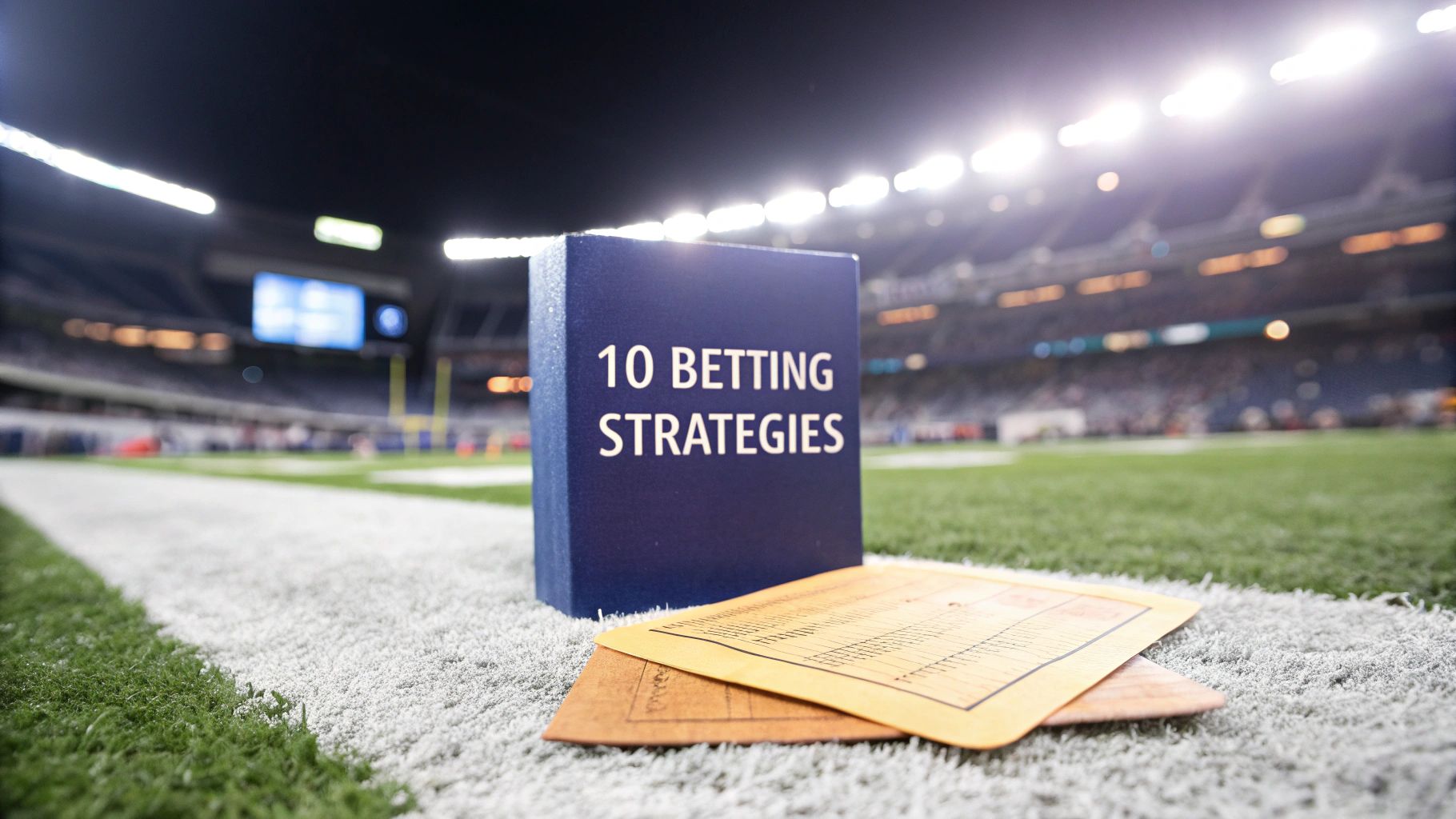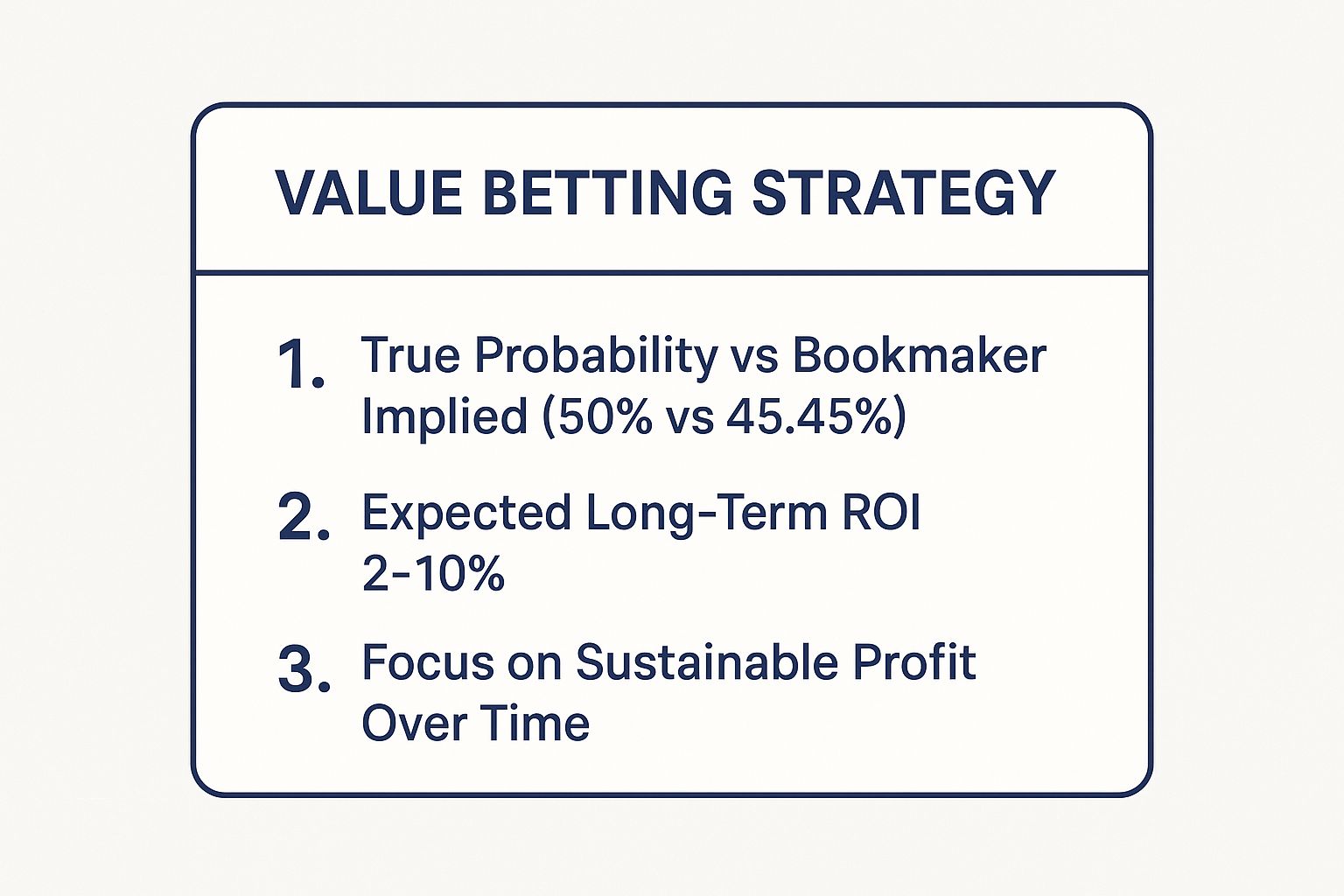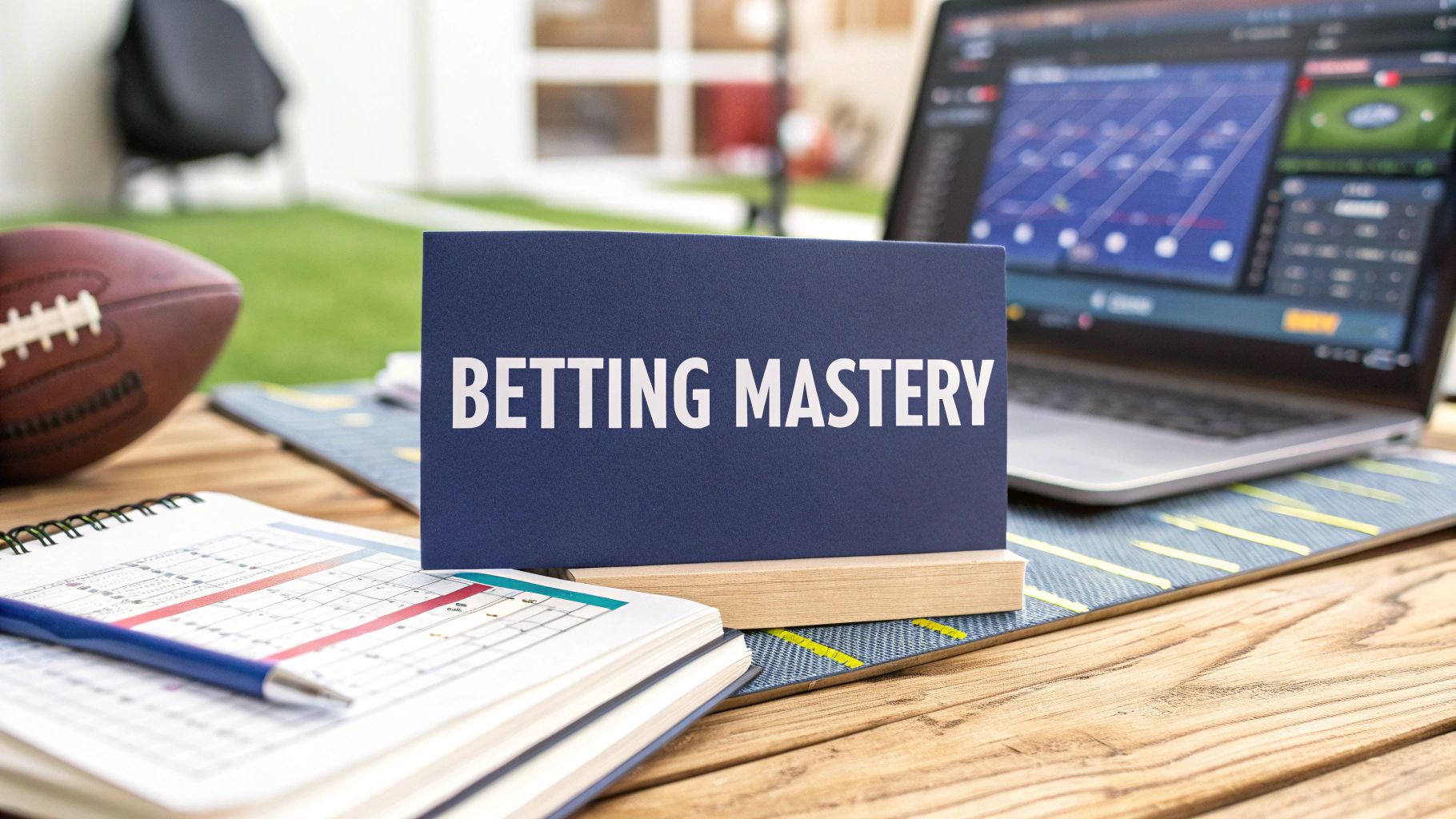
10 Proven Football Betting Strategies for 2025
Unlock long-term profit with our 2025 guide to the top football betting strategies. Learn value, arbitrage, and live betting to win more.
Stop treating football betting like a lottery. The difference between casual punters and consistent winners lies not in luck, but in having a structured approach. This guide breaks down 10 proven football betting strategies, equipping you with the mathematical, analytical, and tactical frameworks used by professionals to gain a decisive edge. Forget guesswork; these are the methods that turn random punts into calculated investments.
We will explore everything from identifying true value in overlooked odds to mastering the nuances of in-play markets. You will learn how to manage your bankroll with precision using systems like the Kelly Criterion and how specialising in specific leagues can yield predictable profits. Each strategy is detailed with actionable steps and real-world scenarios, transforming complex theories into practical tools you can implement immediately.
This is your game plan for making smarter, more confident decisions. And for those looking to streamline this process, we will show how platforms like OddsHaven can automate the heavy lifting, turning complex data into clear, daily opportunities. It's time to move beyond hope and start betting with a genuine strategy.
1. Value Betting Strategy
Forget trying to predict the future with a crystal ball; professional football betting is a game of mathematics, and the Value Betting Strategy is its core principle. This isn't about simply picking winners; it's about identifying odds that are statistically incorrect. You are essentially finding bets where the bookmaker has underestimated a team's true chances of winning, giving you a profitable long-term edge.
The strategy involves calculating the genuine probability of an outcome and comparing it against the bookmaker's implied probability (derived from their odds). When your calculated probability is higher than the bookie’s, you’ve found a “value bet.” For instance, if your model shows Manchester United has a 50% chance of winning (true odds of 2.00), but a bookmaker offers odds of 2.20 (implying a 45.45% chance), that 4.55% difference is your value. This is the cornerstone of successful, data-driven football betting strategies.
Actionable Steps for Implementation
- Develop a Probability Model: Start by creating your own system for calculating probabilities. This can range from a simple Elo rating system in a spreadsheet to more complex Poisson distribution models that analyse historical goal data.
- Compare Odds Relentlessly: Use an odds comparison tool, like the one here at OddsHaven, to scan multiple bookmakers. The best price is essential for maximising your value.
- Master Staking: Employ a consistent staking plan. Flat betting (wagering the same percentage of your bankroll on every bet) is ideal for beginners, while the Kelly Criterion can optimise returns for advanced bettors.
- Record Everything: Keep a detailed record of every bet. Track the odds, stake, bookmaker, and, most importantly, the closing line value (the odds just before kick-off) to measure your strategy's effectiveness.
This infographic summarises the core principles of identifying and capitalising on a value bet.

As the data shows, value betting is not a get-rich-quick scheme but a methodical approach focused on achieving a sustainable 2–10% return on investment over time. This long-term perspective is what separates professional punters from casual gamblers. For a deeper analysis of how odds change and what it means for your bets, you can learn more about finding value in odds movement on our blog.
2. Arbitrage Betting (Sure Betting)
Move beyond hoping for a win and enter the world of guaranteed profit. Arbitrage betting, often called 'arbing' or sure betting, is a mathematically certain strategy that exploits price discrepancies between different bookmakers. It’s not about predicting an outcome; it’s about placing calculated bets on all possible results of a match across multiple sites, locking in a profit no matter which team wins, loses, or draws.
This strategy capitalises on bookmakers’ differing opinions on an event's probability. For instance, Bookmaker A might offer odds of 2.10 on Liverpool to win, while Bookmaker B offers 2.15 on the opposing team not winning (Draw or Loss). By precisely calculating your stakes on both outcomes, you create a situation where your total return exceeds your total investment. This is one of the few genuinely risk-free football betting strategies when executed correctly.
Actionable Steps for Implementation
- Open Multiple Accounts: The more bookmaker accounts you have, the more opportunities you can find. Aim to be registered with at least 10-15 different reputable bookmakers.
- Utilise Arbing Software: Manually finding arbitrage opportunities is nearly impossible as odds change rapidly. Use a dedicated arbitrage alert service to get real-time notifications of profitable discrepancies.
- Act Immediately: Arbs last for minutes, sometimes only seconds. You must be prepared to place your bets quickly and accurately as soon as an opportunity is identified.
- Manage Your Bankroll: Distribute your funds across several bookmaker accounts so you can act instantly. Use an arbitrage calculator to determine the exact stake for each bet to guarantee a balanced profit.
- Bet Discreetly: Avoid using round numbers for your stakes (e.g., £100). Instead, bet precise amounts like £97.83 to avoid being flagged as an arbitrage bettor by bookmakers, who may limit your account.
3. Asian Handicap Betting Strategy
Move beyond the simple win-draw-lose markets and embrace a more nuanced approach with Asian Handicap betting. This strategy effectively eliminates the possibility of a draw, creating a two-way market that sharpens your betting focus. The bookmaker applies a goal deficit (a “handicap”) to the favourite and a head start to the underdog. Your bet wins if your chosen team overcomes its handicap, offering a sophisticated way to manage risk and find value.
The real power of this strategy lies in its ability to balance the odds in seemingly one-sided matches. Instead of accepting prohibitively low odds on a clear favourite, you can back them on a handicap (e.g., -1.5 goals) for a much better price. For instance, backing Manchester City with a -1.5 handicap means they must win by two or more goals for your bet to succeed. This makes it one of the most effective football betting strategies for extracting value from lopsided fixtures.
Actionable Steps for Implementation
- Master the Lines: Start with whole and half-goal handicaps (e.g., -1, +1.5) to understand the basics before exploring more complex quarter-goal lines (-0.75, +1.25) which split your stake.
- Analyse Performance Margins: Don't just look at whether a team wins; research their average winning and losing margins. This data is crucial for predicting if they can cover the handicap.
- Compare Markets for Value: Always check the Asian Handicap odds against the traditional 1X2 market. Often, a -0.5 handicap on a team offers better value than a simple "to win" bet.
- Use It for Favourites: This is the ideal strategy for betting on heavy favourites. It allows you to get worthwhile odds where the standard win market would offer minimal returns.
- Track Your Results: Keep a detailed log of your handicap bets. Note which lines (-1.5, +0.5, etc.) are most profitable for you to identify your specific edge and refine your approach.
4. Fibonacci Betting System
Stepping away from probability models and into the realm of structured staking, the Fibonacci betting system offers a more conservative approach to progressive wagering. This strategy uses the famous Fibonacci sequence (1, 1, 2, 3, 5, 8, etc.) to dictate your stake. The core idea is to increase your stake one step up the sequence after a loss and move two steps back after a win, aiming to recover losses over a series of bets rather than in a single, high-risk wager.
This methodical approach is one of the more tempered football betting strategies, designed to manage your bankroll with more caution than aggressive systems like the Martingale. For example, starting with a £10 unit, a loss would mean your next bet is also £10. A second loss moves you to £20, a third to £30, and so on. A win on the £30 bet would move you back two steps in the sequence, making your next stake £10. It is best applied to bets with odds close to evens (2.00).
Actionable Steps for Implementation
- Select Near Even-Money Markets: This system is mathematically optimised for bets with odds around 2.00. Focus on markets like Asian Handicaps or Over/Under 2.5 goals where the outcome is close to a 50/50 probability.
- Establish a Stop-Loss: Before you place a single bet, decide on a firm stop-loss limit. For instance, you might decide to stop and reset if you reach the eighth level of the sequence (21 units). This prevents a long losing streak from decimating your bankroll.
- Track Your Position: Keep a meticulous record of every bet. You must know exactly where you are in the Fibonacci sequence at all times to execute the strategy correctly. A simple spreadsheet is perfect for this.
- Combine with Sound Analysis: The Fibonacci system is a staking plan, not a selection method. It cannot make a poor bet profitable. You must still apply it to wagers you have researched and believe hold value.
5. Draw Betting Strategy
While most punters are busy trying to pick a winner, a shrewd football betting strategy involves focusing on the often-overlooked draw. This approach capitalises on the fact that draws frequently offer higher odds, typically between 3.00 and 4.00, because the average bettor psychologically prefers to back a team to win. The core of this strategy is identifying matches where the statistical and situational likelihood of a stalemate is significantly higher than the bookmaker’s odds suggest.
This strategy requires a shift in mindset from picking victors to analysing for equilibrium. It involves dissecting factors that lead to tactical gridlock, such as two defensively solid teams cancelling each other out or evenly matched mid-table sides with little to play for. Leagues like Italy’s Serie A or France’s Ligue 1, known for their tactical discipline and lower goal averages, are prime hunting grounds for this approach, as their historical draw percentages are often higher than in other top European leagues.
Actionable Steps for Implementation
- Target Specific Leagues and Teams: Focus your analysis on leagues and teams with a proven, historical tendency for draws. Research leagues where over 30% of matches end level.
- Analyse Tactical Matchups: Look for games between two teams with strong defensive records but modest attacking output. A classic "unstoppable force meets immovable object" scenario is less likely to produce a winner.
- Check Head-to-Head (H2H) History: Scrutinise past results between the two clubs. Some fixtures, particularly local derbies, have a recurring pattern of ending in a draw due to high stakes and cautious play.
- Consider Situational Factors: The context of the match is crucial. End-of-season games where a draw benefits both teams, or first legs of knockout ties, are often ripe for a stalemate as teams prioritise avoiding defeat.
6. In-Play (Live) Betting Strategy
Live betting transforms the spectator into a strategic participant, allowing you to place wagers as the match unfolds. This dynamic approach to football betting strategies moves beyond pre-match analysis and into the realm of real-time tactical assessment. It's about reacting to the flow of the game, identifying momentum shifts, and capitalising on market overreactions to events like goals, red cards, or key substitutions as they happen.
The core principle is to find value in odds that are constantly fluctuating based on in-game events. A team that starts as a heavy favourite might offer better odds after conceding an early goal, even if they are still dominating the match statistically. This is where a sharp bettor can exploit temporary inefficiencies before the market fully adjusts, turning live action into profitable opportunities.

Actionable Steps for Implementation
- Pre-Match Preparation: Don't go in blind. Research team tactics, potential game plans, and key player matchups before kick-off. Have a few potential scenarios in mind (e.g., "If Team A scores first, their odds will likely drop too far").
- Watch the Match Live: This strategy is impossible without watching the game. You need a reliable, low-latency stream to see the action and make decisions before the odds move significantly.
- Focus on Specific Markets: Concentrate on one or two matches at a time. Trying to follow too many games at once will dilute your focus and lead to poor decisions. Popular in-play markets include "Next Team to Score," "Total Goals," and match winner odds.
- Stay Disciplined: Emotional moments, like a sudden goal, can cause wild odds swings. Avoid knee-jerk reactions. Stick to your analysis and wait for the value to present itself, rather than betting for the sake of it.
In-play betting is a high-octane discipline that rewards patience, quick thinking, and a deep understanding of football dynamics. For those looking to master this approach, understanding the nuances of how odds shift in real-time is crucial. You can dive deeper into the tools and techniques required by learning more about real-time odds tracking.
7. Both Teams to Score (BTTS) Strategy
This popular strategy removes the need to predict a winner, focusing instead on whether both teams will find the back of the net. The Both Teams to Score (BTTS) market is a simple yes/no proposition, making it an excellent entry point into data-driven football betting strategies. Its appeal lies in its straightforward nature; you win if both sides score at least one goal, regardless of who wins, loses, or if the match ends in a high-scoring draw. This makes it a thrilling bet that remains live until the final whistle.
Success in BTTS betting hinges on identifying matches ripe for goals at both ends. This involves analysing teams with potent attacks but vulnerable defences. For instance, a mid-table clash in the German Bundesliga between two teams who both average over 1.5 goals scored and conceded per game is a prime candidate. You're not backing a specific outcome, but rather the likelihood of an open, attacking style of football leading to goals from both participants.
Actionable Steps for Implementation
- Target High-Scoring Leagues: Focus your research on leagues known for their attacking football and high goal rates, such as the Dutch Eredivisie or German Bundesliga, where BTTS occurs in over 55% of matches.
- Analyse Form and Statistics: Dig into recent form, paying close attention to home/away scoring and conceding records. Look for teams with a high expected goals (xG) for and against (xGA), indicating offensive chances and defensive frailties.
- Check Head-to-Head (H2H) Data: Review the results of recent meetings between the two clubs. A consistent pattern of both teams scoring in past encounters is a strong positive indicator for a future BTTS bet.
- Monitor Team News: Stay updated on injuries and suspensions. The absence of a key central defender or a first-choice goalkeeper for one team can significantly increase the chances of their opponent scoring, making a BTTS bet more attractive.
8. Under/Over Goals Strategy
Instead of predicting a winner, the Under/Over Goals strategy focuses entirely on the total number of goals scored in a match. This is one of the most popular football betting strategies because it simplifies the analysis: you are betting on whether the final goal tally will be above or below a line set by the bookmaker, most commonly 2.5 goals. This market allows you to find value by analysing a team's offensive firepower against their defensive solidity, independent of the final result.
This approach is about identifying scenarios where a match is likely to be a high-scoring affair or a tight, defensive battle. For example, a clash between two free-scoring Bundesliga teams might present value on Over 2.5 goals, whereas a match between two defensively organised Serie A sides could offer an edge on the Under 2.5 line. The goal is to find where the bookmaker has misjudged the scoring potential of the game.

Actionable Steps for Implementation
- Analyse League-Wide Trends: Begin by researching the average goals per game for different leagues. Some leagues, like the Dutch Eredivisie, are historically high-scoring, while others, like the Greek Super League, are not.
- Drill into Team Statistics: Examine each team's recent form, focusing on goals scored and conceded, both at home and away. Pay close attention to underlying metrics like Expected Goals (xG) to gauge their true attacking and defensive performance.
- Assess Situational Factors: Consider team news for key injuries to strikers or defenders. Weather conditions are also crucial; heavy rain and strong wind often lead to fewer goals and can make an "Under" bet more appealing.
- Evaluate Tactical Matchups: Consider how the teams' styles will interact. A match featuring two counter-attacking teams can often turn into a cagey affair with few goals, creating an opportunity to back the "Under" market.
This strategy shines when you can successfully profile the offensive and defensive capabilities of both teams involved, turning statistical analysis into profitable wagers. It's a fundamental part of any serious bettor's toolkit.
9. Kelly Criterion Staking Strategy
Moving beyond simply picking winners, the Kelly Criterion is a sophisticated staking formula that tells you exactly how much of your bankroll to wager. This mathematical approach, born from information theory, is one of the most powerful football betting strategies for maximising long-term growth. It calculates the optimal bet size by weighing your perceived edge against the odds on offer, effectively balancing risk and reward.
The formula is: (bp - q) / b, where ‘b’ is the decimal odds minus 1, ‘p’ is your calculated probability of winning, and ‘q’ is the probability of losing. For example, if you believe a team has a 55% chance (p=0.55) to win at odds of 2.00 (b=1), Kelly suggests a stake of 10% of your bankroll. This dynamic method ensures you bet more when you have a bigger edge and less when your advantage is small, preventing you from going bust during a losing streak.
Actionable Steps for Implementation
- Start with Fractional Kelly: Full Kelly can be aggressive and lead to high variance. Begin by using a fractional amount, such as 25% or 50% of the recommended stake, to reduce risk while still capitalising on your edge.
- Be Conservative with Probabilities: The formula’s output is only as good as your probability inputs. Overestimating your winning chances is a common pitfall, so always build a margin of error into your calculations.
- Recalculate Your Bankroll Regularly: Your stake size should be a percentage of your current bankroll. Update your total bankroll figure regularly (e.g., daily or weekly) to ensure your stakes adjust accordingly.
- Maintain Meticulous Records: This strategy is reliant on having a proven, positive edge. You must accurately track your performance to confirm your probability models are effective. For more guidance, you can learn about tracking units won and lost on our blog.
The Kelly Criterion is the preferred method for professional syndicates and sharp bettors because it mathematically optimises for portfolio growth. While it requires accurate probability assessment, its disciplined approach is a cornerstone of advanced bankroll management in sports betting.
10. League Specialisation Strategy
Rather than trying to be a jack-of-all-trades across global football, the League Specialisation Strategy advocates for becoming a master of one. This approach involves focusing all your analytical efforts on one or two specific leagues, gaining an informational edge that generalist bookmakers and bettors simply cannot match. By immersing yourself in a particular competition, you develop a deep, nuanced understanding of its teams, player dynamics, managerial tactics, and even referee tendencies.
This specialised knowledge allows you to identify value that others miss. While bookmakers have sophisticated models for major leagues like the Premier League, their attention is more diluted for competitions like the EFL Championship or the Portuguese Primeira Liga. For instance, knowing a key defensive midfielder in a League Two side is injured might not move a bookmaker's line significantly, but a specialist knows this could be the deciding factor in a tight match. This is a core component of many successful, long-term football betting strategies.
Actionable Steps for Implementation
- Select Your Niche: Choose one or two leagues to focus on. Lower-tier leagues or less popular top-flight competitions often present more value opportunities due to less market scrutiny.
- Immerse Yourself in Information: Go beyond basic statistics. Follow local sports journalists on social media, read team-specific forums, and watch as many full matches as possible, not just the highlights.
- Build a Knowledge Base: Create your own database tracking key factors like injuries, suspensions, team morale, and specific tactical matchups. This becomes your unique analytical tool.
- Track Your Performance: Meticulously record every bet within your chosen league. This helps you identify what information is most predictive and allows you to refine your approach, confirming you have a genuine edge.
This strategy transforms betting from a broad guessing game into a focused, expertise-driven investment. By dedicating your time, you can develop an informational advantage that consistently uncovers profitable opportunities overlooked by the wider market. To find the best odds across these niche markets, always use an odds comparison tool like the one here at OddsHaven.
Top 10 Football Betting Strategies Compared
| Strategy | Implementation Complexity 🔄 | Resource Requirements 🔄 | Expected Outcomes 📊 | Ideal Use Cases 💡 | Key Advantages ⭐ |
|---|---|---|---|---|---|
| Value Betting Strategy | High – requires statistical analysis and probability calculation | High – data gathering, modeling, time investment | Medium-High – long-term ROI 2-10% | Long-term profit seekers; all markets and leagues | Mathematically profitable; removes emotion |
| Arbitrage Betting (Sure Betting) | Medium-High – requires fast execution and multiple accounts | High – multiple bookmaker accounts, capital | Low-Medium – small guaranteed returns (0.5-5%) | Risk-free profit exploitation across bookmakers | Guaranteed profit when successful |
| Asian Handicap Betting Strategy | Medium – understanding handicaps and score adjustments | Medium – knowledge of handicaps and team data | Medium – reduced variance, better odds | Matches with clear favorites or strong defensive teams | Lower variance; better value on favorites |
| Fibonacci Betting System | Medium – tracking Fibonacci sequence and staking adjustments | Low-Medium – bankroll management and record keeping | Medium – risk managed loss recovery | Even-money bets; conservative progressive staking | More conservative than Martingale |
| Draw Betting Strategy | Medium – requires tactical and statistical analysis | Medium – focus on specific leagues and draw data | Medium – higher odds but infrequent wins | Defensive leagues; high-draw probability matches | High odds; less competition |
| In-Play (Live) Betting Strategy | High – demands fast reaction and strong tactical knowledge | High – requires watching matches and quick decision-making | Variable – depends on skill, can exploit in-play inefficiencies | Matches where live data can be leveraged | Capitalizes on market overreactions |
| Both Teams to Score (BTTS) Strategy | Low-Medium – simple yes/no market analysis | Medium – requires offensive/defensive stats | Medium – occurs ~50% of matches with decent odds | Attack-minded leagues and matches | Straightforward; not result-dependent |
| Under/Over Goals Strategy | Medium – requires pattern analysis and situational evaluation | Medium – statistical data and match-specific info | Medium – predictable scoring-based outcomes | Popular across all leagues, adaptable to multiple markets | Numerous market options; data-driven |
| Kelly Criterion Staking Strategy | Medium – mathematical bet sizing formula use | Medium – requires probability estimation and record keeping | High – maximizes bankroll growth while managing risk | Professional bettors with accurate edge estimation | Optimal bankroll growth; risk minimization |
| League Specialization Strategy | Medium – deep research on limited leagues | Medium – time and data focused on chosen leagues | Medium-High – improved edge from specialized knowledge | Bettors focusing on few leagues for deeper insights | Expert knowledge yields value opportunities |
Choosing Your Strategy and Automating Your Edge
You now have a comprehensive arsenal of ten powerful football betting strategies at your disposal. From the mathematical precision of the Kelly Criterion and Value Betting to the market-focused intelligence of the Asian Handicap and Draw Betting strategies, each offers a unique pathway to more informed and potentially profitable wagering. We have explored how to specialise in niche leagues, leverage the dynamic nature of in-play betting, and exploit specific markets like BTTS and Under/Over Goals.
The crucial takeaway is that there is no single "holy grail" strategy. Your success will not come from randomly applying every method, but from a deliberate and disciplined approach. The most successful punters are those who identify one or two strategies that resonate with their personality, risk tolerance, and available time commitment. Are you an analytical mind drawn to calculating value, or a keen observer who thrives on the fast-paced decisions of live betting? This self-awareness is your first and most important strategic choice.
From Theory to Disciplined Application
Mastering any of these approaches requires dedication. Manually sifting through team statistics, monitoring live odds fluctuations across multiple bookmakers, and calculating implied probabilities for every match is an immense, time-consuming task. Consistency is the bedrock of long-term success, and maintaining that consistency manually can lead to burnout, emotional decisions, and costly errors. This is where modern tools create an undeniable advantage.
Key Insight: The difference between an amateur and a professional bettor often lies not in the strategy itself, but in the unwavering discipline and efficiency of its execution.
Automating the analytical heavy lifting is no longer a luxury; it is a strategic imperative. By leveraging technology, you can remove the emotional guesswork and the hours of tedious research from the equation. This allows you to focus your energy on what truly matters: bankroll management, strategic staking, and making the final, confident decision based on high-quality, pre-analysed data. You transition from being a researcher to being a strategic decision-maker, which is precisely where you want to be.
The journey to becoming a more sophisticated bettor begins now. Choose the football betting strategies that align with your goals, commit to mastering their principles, and use the powerful tools available to execute them with professional-grade precision. By combining proven theory with technological efficiency, you elevate your approach from a simple hobby to a calculated and sustainable endeavour.
Ready to put these strategies into action without the manual grind? OddsHaven leverages sophisticated AI to analyse thousands of matches, identifying high-value picks and expertly curated parlays daily. Let our technology do the hard work so you can bet with data-driven confidence. Explore your winning edge with OddsHaven today.
Ready to Start Winning?
Join OddsHaven and get instant access to AI-powered predictions with an 87% win rate on high-confidence picks
Try OddsHaven Free for 5 Days

